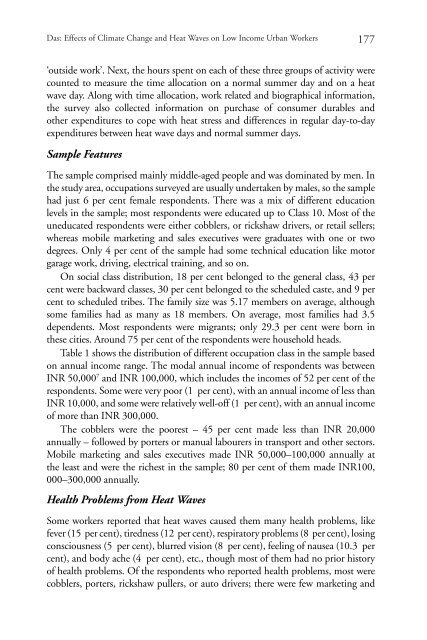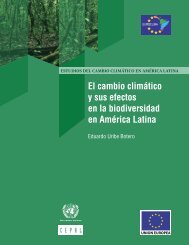Inequality and Climate Change Inégalité et changement climatique
Inequality
Inequality
You also want an ePaper? Increase the reach of your titles
YUMPU automatically turns print PDFs into web optimized ePapers that Google loves.
Das: Effects of <strong>Climate</strong> <strong>Change</strong> <strong>and</strong> Heat Waves on Low Income Urban Workers 177<br />
‘outside work’. Next, the hours spent on each of these three groups of activity were<br />
counted to measure the time allocation on a normal summer day <strong>and</strong> on a heat<br />
wave day. Along with time allocation, work related <strong>and</strong> biographical information,<br />
the survey also collected information on purchase of consumer durables <strong>and</strong><br />
other expenditures to cope with heat stress <strong>and</strong> differences in regular day-to-day<br />
expenditures b<strong>et</strong>ween heat wave days <strong>and</strong> normal summer days.<br />
Sample Features<br />
The sample comprised mainly middle-aged people <strong>and</strong> was dominated by men. In<br />
the study area, occupations surveyed are usually undertaken by males, so the sample<br />
had just 6 per cent female respondents. There was a mix of different education<br />
levels in the sample; most respondents were educated up to Class 10. Most of the<br />
uneducated respondents were either cobblers, or rickshaw drivers, or r<strong>et</strong>ail sellers;<br />
whereas mobile mark<strong>et</strong>ing <strong>and</strong> sales executives were graduates with one or two<br />
degrees. Only 4 per cent of the sample had some technical education like motor<br />
garage work, driving, electrical training, <strong>and</strong> so on.<br />
On social class distribution, 18 per cent belonged to the general class, 43 per<br />
cent were backward classes, 30 per cent belonged to the scheduled caste, <strong>and</strong> 9 per<br />
cent to scheduled tribes. The family size was 5.17 members on average, although<br />
some families had as many as 18 members. On average, most families had 3.5<br />
dependents. Most respondents were migrants; only 29.3 per cent were born in<br />
these cities. Around 75 per cent of the respondents were household heads.<br />
Table 1 shows the distribution of different occupation class in the sample based<br />
on annual income range. The modal annual income of respondents was b<strong>et</strong>ween<br />
INR 50,000 7 <strong>and</strong> INR 100,000, which includes the incomes of 52 per cent of the<br />
respondents. Some were very poor (1 per cent), with an annual income of less than<br />
INR 10,000, <strong>and</strong> some were relatively well-off (1 per cent), with an annual income<br />
of more than INR 300,000.<br />
The cobblers were the poorest – 45 per cent made less than INR 20,000<br />
annually – followed by porters or manual labourers in transport <strong>and</strong> other sectors.<br />
Mobile mark<strong>et</strong>ing <strong>and</strong> sales executives made INR 50,000–100,000 annually at<br />
the least <strong>and</strong> were the richest in the sample; 80 per cent of them made INR100,<br />
000–300,000 annually.<br />
Health Problems from Heat Waves<br />
Some workers reported that heat waves caused them many health problems, like<br />
fever (15 per cent), tiredness (12 per cent), respiratory problems (8 per cent), losing<br />
consciousness (5 per cent), blurred vision (8 per cent), feeling of nausea (10.3 per<br />
cent), <strong>and</strong> body ache (4 per cent), <strong>et</strong>c., though most of them had no prior history<br />
of health problems. Of the respondents who reported health problems, most were<br />
cobblers, porters, rickshaw pullers, or auto drivers; there were few mark<strong>et</strong>ing <strong>and</strong>





